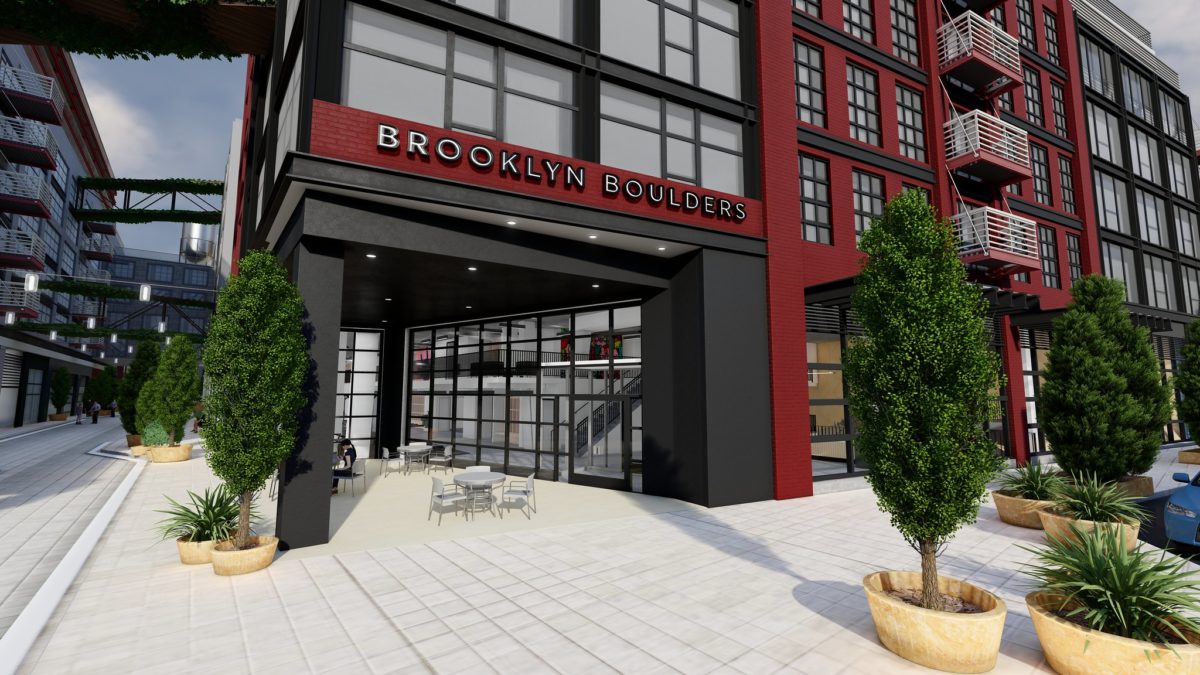As we move closer and closer to a post-vaxxed world, there’s a new attraction to get excited for: This fall, D.C. is getting a new indoor rock climbing gym in Eckington.
New York City-based Brooklyn Boulders is opening a D.C. location in the new Eckington Yards building later this year (they’re aiming for late September, but an official date is TBD). Featuring multiple climbing walls plus youth and adult programming, the 31,000-square-foot space will also include a flexible-use area for events like open mic nights and parties, as well as coworking (they don’t sell seats, but members can enter the space and use it at any time and non-members can purchase a day pass).
It’s the latest expansion for the company, which opened it’s doors in 2009 and has additional locations in Boston and Chicago. While there are individual walls at a few locations within the District, this will be the first gym completely dedicated to indoor bouldering.
“D.C. doesn’t have a climbing gym within the heart of the city within the metro area, and we think our focus on community and for this to be like a third space [and] a gathering point, really fits well for D.C.,” CEO Martin Adler told Technical.ly. “Also, the technology progression component we think is a good fit.”
But the real star of the show is the touch-sensitive, interactive rock climbing wall Brooklyn Boulders has developed. Instead of traditional, brightly-colored grips, LED lights on the holds will show users the pathway they should be following. When they want to begin climbing, participants can log in, and select a climb from an iPad that communicates with a computer behind the wall. Since there’s a touch-sensitive sensor array on each hold, the system knows how much of the course has been completed, and can track the progress of climbers.
“This is now a wall that’s completely driven by a computer,” Adler said. “The data structure is driving the experience, so it’s quantifying your progress. It’s dynamic, it adapts to people’s progress and it can be personalized.”
Brooklyn Boulders is also set to launch an accompanying app in the near future, available for iPhones and developed with native iOS code, that lets users scan in with a QR code. The app will also send climbers emails about their progress, since the sensors are touch-sensitive.
Adler declined to share exactly how the sensors know someone is moving around the course, so it could be anything from a force sensor to optical to heat. But in general, he said the “secret sauce” is that the idea more or less turns indoor climbing into a big video game system, where climbers can interact with the system and change their environment.
“It’s more conducive to social experience and play because it’s more like a game,” Adler said. “In a world where there are a lot of people spending time playing video games, they’re used to a level of personalization and responsiveness, and climbing to date has been fully static.”

Inside Brooklyn Boulders. (Courtesy photo)
By knowing what courses have been completed and how quickly, the computer can track areas for improvement. Adler also said it has the ability to determine how weight is being distributed between holds, so they can teach people techniques more efficiently. It’s also great for beginners, he added, because they can modify the difficulty level so newbies can have the right amount of challenge and prevent burnout.
“One very common challenge in climbing is learning to use your feet instead of just your arms, and we can literally view the extent to which you’re you’re putting weight on each hold, which helps us teach people to be more efficient at the sport,” Adler said.
Although the Brooklyn Boulders gym will be about as decked out with tech as indoor climbing can get, Adler said certain aspects like route-setting (aka course designing) are still being done old-school at the moment. But he hopes to continue merging technology and climbing as the company grows.
“[Technology] just gives a lot more precision and view into what you’re capable of doing and where you may have had challenges,” Adler said. “So especially as we gather more data and more people use the system, we can determine what it looks like to be successful versus unsuccessful, and what the differentiating factors are.”
Join the conversation!
Find news, events, jobs and people who share your interests on Technical.ly's open community Slack

DC daily roundup: Esports at Maryland rec center; High schoolers' brain algorithm; Power data centers with coal?

DC daily roundup: Tyto Athene's cross-DMV deal; Spirit owner sells to Accenture; meet 2GI's new cohort

DC daily roundup: $10M to streamline govt. contracting; life sciences might dethrone software; Acadia's new $50M


